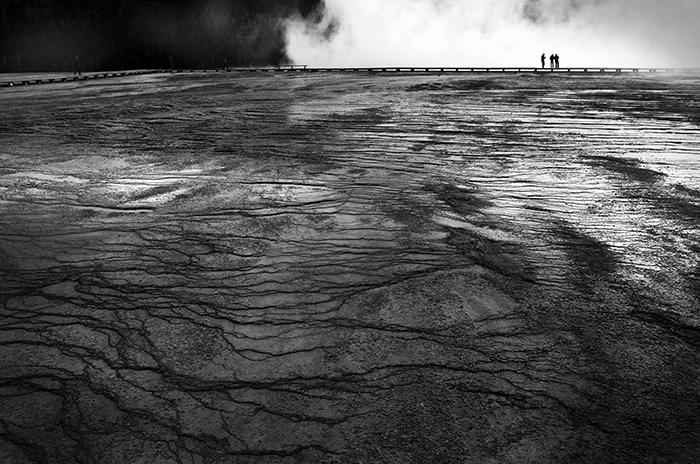2014 Vergil America 10th Anniversary Invitational Exhibition
In The Mountain
Hongjeon Lee

Changes the mountain brought about…
There have been some changes in the artist Hong-Jeon Lee’s recent works concerning the contents and the method. First of all, looking from a perfunctory perspective, we could observe how Lee’s use of pure, abstract expressions in his previous works has transformed to include more shapes such as mountains and valleys. Also, these shapes are formed with a sense of movement while restraining as much as possible from detailed descriptions, and they are portrayed not in a standardized, calculated way but in a way where materials like paints naturally blend in together. In his picture plane, his inevitable gestures correspond with accidental effects to remove the artificial feeling as much as possible, thus giving off an atmosphere in which the picture develops its own order. With respect to colors, he uses blue colors in monotone, yellow or green colors in low chroma, instead of using colorful, primary colors that have both high chroma and brightness.
Looking at the proposition of his work, the contents have transformed towards more symbolic and metaphoric expressions as can be observed in the title of the exhibition “In the mountain” from the inner, soliloquy-like expressions evident in his previous works. Of course, considering the tendency of Lee’s works, we could discover that the propositions of this exhibition, “Mountain-Life” and “Mountain-Thirst”, are extensions of his previous works in that the lyrical sensation connects with the inner problems of mankind. Moreover, his method of approach draws attention because he does not display direct sensitivity but rather uses a restrained form of euphemism to discuss the deep, hidden emotions reflected in symbolic subjects like mountains.
In his previous works, he had directly expressed explicit and passionate inner energy on top of the motion and rhythm of color and brush. While the motion of color and brush is still alive in his recent works, they also make us sense in a very refined way the lyrical metaphor along with the calm wave echoing back from a mountain or a valley.

The mountain the artist Hong-Jeon Lee encounters is full of vitality also present in his previous works, but we can also discover a sense of extreme thirst. In fact, his sympathetic and affectionate view towards human society is instilled in the deep emotion expressed in his previous works. The expression of energy in his abstract works was based on these supporting forces. So while his works were abstract, they were also formative remarks. Through the process of such works, something beyond the colorful and intense paintings on the art plane, which used to lay deep in the artist’s mind, seems to have come up to the surface in a symbolic form of a mountain.
These are not simply free-wheeling, momentary feelings or emotions but more like compassion towards the mountain and the valley which are to be full of vitality and like pity towards the world in which people are getting hard-hearted. They are presented as the propositions of works and expressed by formative elements in this exhibition. So, in his works to be displayed in the exhibition, Lee attempts to emphasize the cracks and accidental touches that are made from the repulsion of watercolors and oil paints. In this sense, he refrains from using various colors in order to refine the artificial expression and portray subtlety.

In fact, the song about life which Lee had described before in his painting was colorful and passionate but seemed to imply heaviness and expose a surplus of wounded emotion deep inside.
When looking at his past works in detail, red, yellow, and blue paints have elaborately decorated the white canvas as if dancing, but entirely different elements such as geometric figures or even a figure of a coin sometimes appeared as well. Such things may have been clues to what was left beyond the colorful surface of canvas. In retrospect, I come to think that the harmony on the canvas was simply playing the role of a fancy decoration, covering up the relatively hidden side of the painting.
However, after Lee encountered the mountain, it seems that he realized his previous colorful song of life was a prelude for healing wounds. Then now, he not only expresses energetic remarks but also seems to hear the sound of the mountain.
I come to think if the mountain Lee encountered wasn’t “the sincere but hidden hearts of the ones who is so full of love that they wanted to tell and do something without any reward? Or wasn’t it the inner, soliloquy-like sincerity from deep inside Lee’s mind which he has been trying to ignore?”
In any case, Lee’s recent works seem to ask the same meaningful questions to their audiences as well. While it might have become a little easier to approach the paintings with more formative elements and refined painting planes, it is not quite easy to pass by because it requires us think more seriously, and this is where lies the subtle charm of the exhibition.
Lee is now talking with the mountain, and he hands the conversation to us. The mountain is thirsty, but life is still wriggling.








